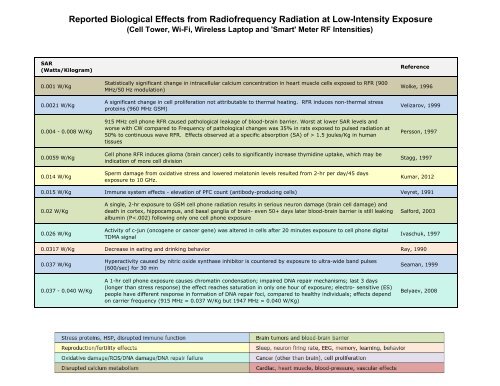Table 1-2 - BioInitiative Report
Table 1-2 - BioInitiative Report
Table 1-2 - BioInitiative Report
Create successful ePaper yourself
Turn your PDF publications into a flip-book with our unique Google optimized e-Paper software.
SAR<br />
(Watts/Kilogram)<br />
0.001 W/Kg<br />
0.0021 W/Kg<br />
0.004 - 0.008 W/Kg<br />
0.0059 W/Kg<br />
0.014 W/Kg<br />
<strong>Report</strong>ed Biological Effects from Radiofrequency Radiation at Low-Intensity Exposure<br />
(Cell Tower, Wi-Fi, Wireless Laptop and 'Smart' Meter RF Intensities)<br />
Statistically significant change in intracellular calcium concentration in heart muscle cells exposed to RFR (900<br />
MHz/50 Hz modulation)<br />
A significant change in cell proliferation not attributable to thermal heating. RFR induces non-thermal stress<br />
proteins (960 MHz GSM)<br />
915 MHz cell phone RFR caused pathological leakage of blood-brain barrier. Worst at lower SAR levels and<br />
worse with CW compared to Frequency of pathological changes was 35% in rats exposed to pulsed radiation at<br />
50% to continuous wave RFR. Effects observed at a specific absorption (SA) of > 1.5 joules/Kg in human<br />
tissues<br />
Cell phone RFR induces glioma (brain cancer) cells to significantly increase thymidine uptake, which may be<br />
indication of more cell division<br />
Sperm damage from oxidative stress and lowered melatonin levels resulted from 2-hr per day/45 days<br />
exposure to 10 GHz.<br />
Reference<br />
Wolke, 1996<br />
Velizarov, 1999<br />
Persson, 1997<br />
Stagg, 1997<br />
Kumar, 2012<br />
0.015 W/Kg Immune system effects - elevation of PFC count (antibody-producing cells) Veyret, 1991<br />
0.02 W/Kg<br />
0.026 W/Kg<br />
A single, 2-hr exposure to GSM cell phone radiation results in serious neuron damage (brain cell damage) and<br />
death in cortex, hippocampus, and basal ganglia of brain- even 50+ days later blood-brain barrier is still leaking<br />
albumin (P



